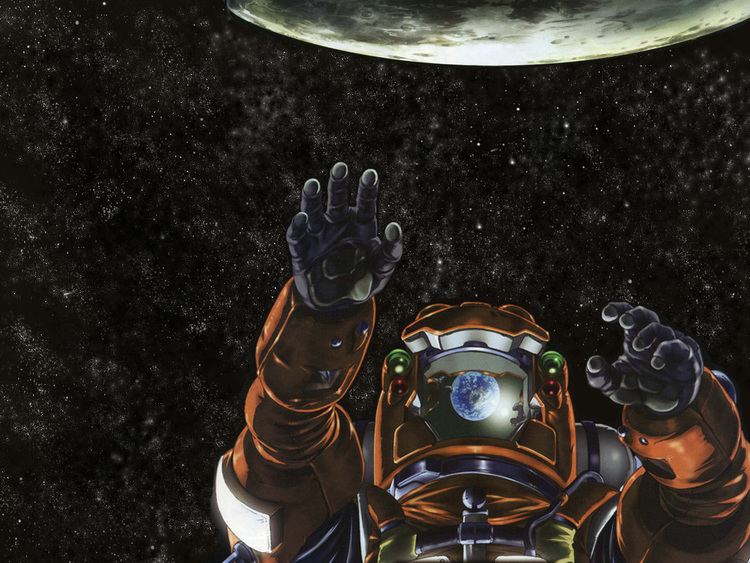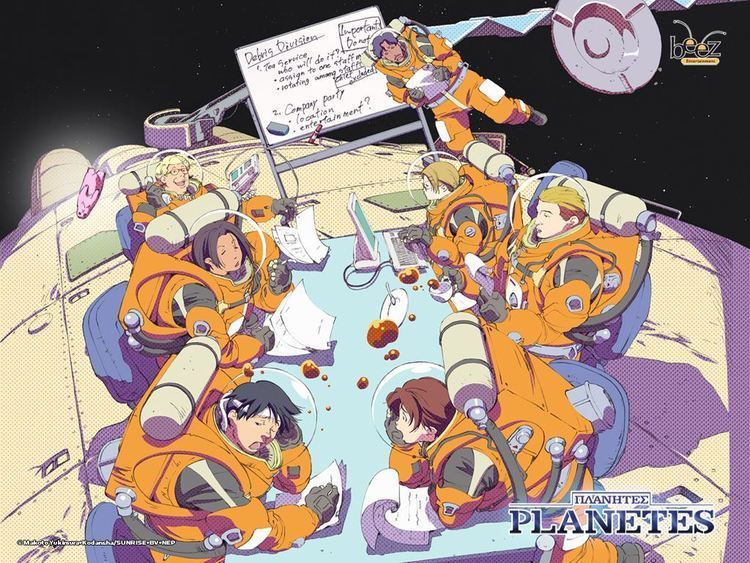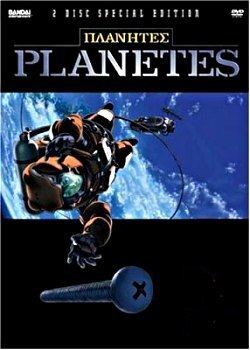Directed by Gorō Taniguchi Magazine Weekly Morning Music by Kōtarō Nakagawa | Adaptations Planetes (2003) | |
 | ||
Original run January 1999 – January 2004 Similar Blue Submarine No 6, The Candidate for Godde, Gunslinger Girl, Miyuki‑chan in Wonderland, Legal Drug | ||
Planetes (プラネテス, Puranetesu, Ancient Greek: Πλανήτες Planētes, literally meaning, by Ancient Greek translation, "Planets", or "Wanderers") is a Japanese hard science fiction manga written and illustrated by Makoto Yukimura. It was adapted into a 26-episode anime television series by Sunrise, which was broadcast on NHK from October 2003 through April 2004. The story revolves around the crew of the debris collection craft, Toy Box, in the year 2075.
Contents
- Planetes manga review
- Plot
- Characters
- Technical
- Human elements
- Themes
- Production
- Manga
- Anime
- Reception
- References

The manga was published in English in North America by Tokyopop, and the anime was distributed in North America by Bandai Entertainment. Both the manga and anime received the Seiun Award for best science fiction series.

Planetes manga review
Plot

The story of Planetes follows the crew of the DS-12 "Toy Box" of the Space Debris Section, a unit of Technora Corporation. Debris Section's purpose is to prevent the damage or destruction of satellites, space stations and spacecraft from collision with debris in Earth's and the Moon's orbits. They use a number of methods to dispose of the debris (mainly by burning it via atmospheric reentry or through salvage), accomplished through the use of EVA suits.

The episodes sometimes revolve around debris collection itself, but more often the concept of collecting "trash" in space is merely a storytelling method for building character development. The members of the Debris Section are looked down upon as the lowest members of the company and they must work hard to prove their worth to others and accomplish their dreams.

Ongoing plot elements include an upcoming exploratory mission to Jupiter on the new fusion powered ship, Von Braun, and the lead character's decision to join the mission, no matter the cost. Many other plot threads are also developed throughout the series that help to explain each character's motivations and personalities. The Space Defense Front is a terrorist organization that believes mankind is exploiting space without first curing global problems such as mass famine and the widened socio-economic divide on Earth.
Characters

Technical
The story of Planetes takes place in the near future. Special care was given in Planetes for a very realistic depiction of space and space travel. For instance, when in a weightless environment, the frame count dramatically increases in order to make weightless motion more fluid and realistic. Also, spaceships make no noise in the vacuum of space and astronauts routinely suffer from known space illnesses such as radiation poisoning, decompression sickness, cancer, brittle bones and mental illnesses spawned from isolation in the vacuum of space. But in an example of a non-scientific idea, one character, born on the Moon, grew to be abnormally tall due to the lesser lunar gravity, looking like an adult at the age of 12.
Concepts like momentum in weightlessness are early plot points and are always illustrated naturally. Director Goro Taniguchi stated in the DVD commentary that he learned much about orbital mechanics in the course of making the series. This can be shown in showing specific orbital energy, through changing orbits by applying thrust throughout the series. Even the necessity for the retrieval of space debris that is central to the plot is rooted in the serious and growing problem with space debris today.
The show also works to connect itself to the history of rocketry and space flight. The opening sequence is similar to the television series Star Trek: Enterprise, featuring a montage of the history of space flight from Greek mythology to the "modern" setting outlined in the series. Along the way, animated images of important milestones in space travel like Robert Goddard's early rocket tests, the V-2 rocket, Sputnik 1, Laika the dog, the Vostok spacecraft, Apollo 11, Skylab, Mir, the International Space Station and the Space Shuttle Endeavour and other milestones are displayed. References to early pioneers in rocketry like Konstantin Tsiolkovsky, Robert H. Goddard, Wernher von Braun and Hermann Oberth are also made regularly.
The Japanese space agency JAXA served as a technical consultant to the series. The US version of the DVDs featured interviews with two scientists from NASA's Orbital Debris Section. However, both scientists stated that the premise of having to rendezvous with debris in orbit is highly unlikely as it would take an extravagant amount of energy for a relatively small amount of salvageable material. One of the scientists stated that the previous director of the NASA Orbital Debris Section was in fact Donald J. Kessler, the scientist who proposed the eponymous Kessler Syndrome, which is cited and used several times in both the anime and manga.
Human elements
The story also depicts the richer countries monopolizing resources in space and the poorer ones falling into civil war and being invaded or needing the assistance of those richer countries, telling a story of dependency theory and the negative side of environmentalism. The conflicting views of the terrorist group, the Space Defense Front, who wish to shut human beings off from space, the main characters who believe in the importance of space exploration and development, and the International Treaty Organization (INTO) which wants space development primarily to serve the economic and military needs of developed nations also play major roles. The anime refrains from oversimplification of the various factions, portraying both true believers and those with ulterior motives on all sides. The final settlement of the conflict is also unique in that it is not resolved by any of the main protagonists or antagonists, but by a compromise struck between powers above their heads.
Both the anime and manga set a precedent of portraying a highly multicultural cast of characters. Usually, characters who refer to anime stereotypes are immediately berated by other characters.
Themes
The themes in Planetes are philosophical, sociological, and political in nature.
Production
Though author/illustrator Makoto Yukimura does not have a background in the sciences, the idea of Planetes came to him while reading a book called A Garbage Problem in Space: Space Debris, and found the Japanese phonetics for the word debris (deburi (デブリ)) amusing. Yukimura intentionally did not research space technology for fears that it would compromise his artistic freedom.
The presentation of technology in the anime adaptation broke from the manga in several areas, such as with the inclusion of touch-controlled HUDs, retractable debris face shields with a video screen, and peripheral cameras to the EVA suits the main characters use. Also, the anime introduces refinements in the weightless living and working spaces, with foot and hand bars for people to stabilize their movement in a weightless environment. The base of operations of Toy Box is moved from the Moon to a space station called the ISPV 7 in Low Earth Orbit. The United States of America is explicitly named in the manga, as opposed to in the anime where it is seldom mentioned in favor of "INTO" or the International Treaty Organization (a possible reference to NATO and SEATO), which seems to be a federation of individual countries including the United States and Japan.
Planetes shared part of its production staff with another anime series that ran at the same time on NHK, Twin Spica. From this, the production staff slipped several easter egg cross overs into Planetes. Some of these include:
There are several times where the anime and the manga would allude to each other. The following are some examples of this:
Manga
Written and illustrated by Makoto Yukimura, the twenty-six chapters appeared as a serial in the Kodansha Seinen manga magazine Weekly Morning from January 1999 to January 2004. Kodansha collected the chapters into four tankōbon volumes, and published them from January 23, 2001, to February 23, 2004. It was licensed for an English-language translation in North America by Tokyopop. It published the series in five volumes by splitting the last volume in two parts from October 7, 2003, to February 8, 2005. The translation will be rereleased in two omnibus volumes by Dark Horse Comics starting December 9, 2015.
Anime
The anime adaptation of Planetes began airing its 26-episode run on NHK BS-2 on October 4, 2003 and ended on February 23, 2004. Produced and animated by Sunrise, it was directed by Gorō Taniguchi and scripted by Ichirō Ōkouchi. The anime began development and production before the end of the manga serialization. In the beginning and middle of the series, the writing and production staff only had the first three volumes of the manga as source. In order to fill the entire 26-episode run of the anime, new characters, new settings and new relationships between characters were made in order to increase dramatic tension, reinforce themes introduced in the manga, and introduce new themes that were compatible with the manga. While the manga deals more with existential themes, and humanity's relationship with space, the anime further expands the political elements of the story.
The music score was composed by Kōtarō Nakagawa and produced by Victor Entertainment. The opening theme is "Dive in the Sky" by Mikio Sakai, and the ending themes are "Wonderful Life" by Mikio Sakai for episodes 1-25 and "Planetes" by Hitomi Kuroishi for episode 26. There are two insert songs, "A Secret of the Moon" by Hitomi Kuroishi, used in various episodes, and "Thanks My Friend" by Mikio Sakai used in episode 13.
Reception
Both the manga and the anime were critically acclaimed. According to Anime News Network, the manga has a "solid, engrossing storyline and well-developed characters". Anime News Network also proclaimed Planetes to be the best science fiction anime series of 2005. Both the manga and anime received the Seiun Award for best science fiction series, the manga in 2002 and the anime in 2005.
Sales-wise, the manga was only a modest success in North America, with volume 3 reaching 81st place on the Diamond US sales top 100, selling about 1100 copies through the distributor. Volume 4 reached 93rd place, selling about 1400 copies.
